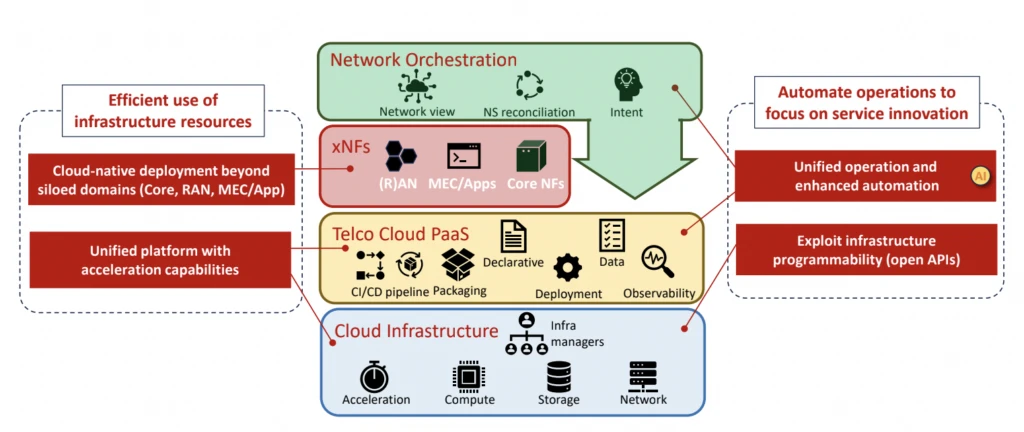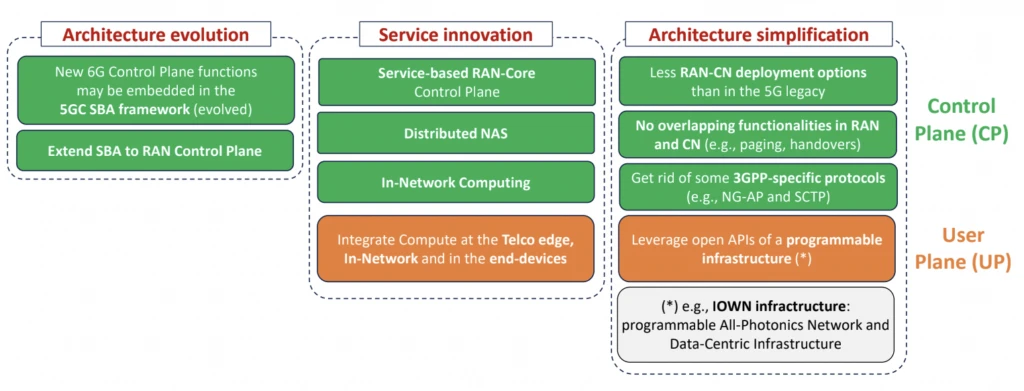The evolution from 5G to 6G core networks will include new requirements for AI, interoperability, positioning, sensing, sustainability, and more.
There is currently a strong focus on bringing cloud-native technologies and operating principles into 5G, with the move to standalone 5G architectures and a cloud-native 5G core being the next big transition that will impact how 6G will be designed, standardized and deployed. In addition to the many enhancements to the 5G core that will be built into 6G, the next generation of cellular also has a number of new requirements.
At the recent Telco Cloud and Edge Forum, available to watch on demand here, Riccardo Guerzoni, director of the Core Network Group at Docomo Euro-Labs, laid out the path from 5G to 6G with a focus on core network considerations. Guerzoni highlighted five design considerations that are broadly related to infrastructure/platform and 3GPP architecture perspectives:
The overall point, according to Guelzoni, is that 6G and the enhancements and new requirements that come with it need to be aligned with the economic realities operators face and deliver a clear return on investment. “These new requirements from 5G onwards are challenging in terms of environmental sustainability – energy efficiency, hardware longevity and economic feasibility,” he said. “These innovative services we expect in the 2030s will require improved network performance and new capabilities and they have to be justified in terms of return on investment. So the question is how to make these new services, which are very demanding, economically viable.”

The first set of considerations Guerzoni mentioned is around the infrastructure/platform piece. Efficient use of infrastructure resources Eliminate traditional silos such as core, RAN, mobile edge computing and network applications and consider a cloud-native deployment with an integrated foundational platform with acceleration capabilities. Automated operations to enable service innovation We’ll discuss integrated automation and operations, and discuss infrastructure programmability via network APIs.
“You have the cloud infrastructure, you have the telco cloud platform as a service built on top of it, and that’s the enabler of the integrated platform with acceleration,” Guerzoni explained. “So acceleration is important not just for core network functions like 5G, but also for running components.” [like open distributed units]… and applications. So the idea is that these acceleration capabilities will not only be used to host RAN components, but also application-related components that can be provided by the operator itself or on behalf of a third party.”

There are three main considerations regarding the 3GPP-defined architecture:
- Architectural Evolution—New 6G control plane capabilities are likely to be incorporated into the evolved 5G core service-based architecture framework, extending the service-based architecture to the RAN control plane.
- Service Innovation—Service-based RAN/core control plane, distributed non-access layer, in-network computing, and convergence of computing at the telco edge based on in-network and on-device computing.
- Simplified architecture—Fewer RAN/Core deployment options, no duplicate RAN/Core functions such as paging and handover, removal of some 3GPP-specific protocols such as NG-AP and SCTP, leveraging programmable infrastructure and programmable all-photonics network and data center infrastructure.
“With regard to extending the SBA architecture defined for 5G to host 6G control plane functions, [above] “This diagram shows a possible perspective that could be used as an approach for 3GPP standardization: 6G core network functions and 6G RAN control plane functions could be hosted in the same 5G SBA framework, but of course enhanced,” said Guelzoni. “Today, 5G core functions are deployed in a centralized cloud, but if we want to include functions of the SBA framework also at the edge, such as RAN control plane functions, we may need to make the protocol stack more resilient, so this enhancement is necessary.”
He also noted that with 6G, “there is no non-standalone option… this is a lesson learned from the 5G experience… the 6G RAN is only integrated with the 6G core network functions, it does not directly interact with them, and interoperability is achieved through service-based interactions between the 5G core and the 6G core.”
From the cloud-native descriptor applied to 5G, 6G is often characterized as AI-native. In this regard, Guelzoni said, “By embedding AI capabilities, we can make the functionality of the network more efficient. We also reduce energy consumption, optimize the operation of the control plane, the quality of experience, the quality of service, etc. So, AI models will be embedded in various parts.[s] This is of course a huge opportunity, but also a challenge from the perspective of mobile network operators. [machine learning] “Model management is needed to build models, deploy them, monitor their performance, make them controllable, train and evaluate them. So how to make these ML models that are deployed in different parts of the network controllable and observable is a very important topic for mobile network operators.”


